Pole Position
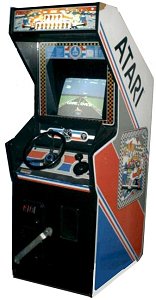
 The Game: Prepare to qualify! Fly to the finish line in a fierce field of Formula One competitors in a qualifying lap. Leaving the track is trouble – and hitting one of the billboards dotted around the edges of the Mt. Fuji track is a sure way to miss out on the subsequent race. (I’ve always wondered anyway: why are there billboards around a racetrack? Are race car drivers a desirable demographic to advertisers? Can they actually read those signs at 200+ MPH?) (Atari [under license from Namco], 1982)
The Game: Prepare to qualify! Fly to the finish line in a fierce field of Formula One competitors in a qualifying lap. Leaving the track is trouble – and hitting one of the billboards dotted around the edges of the Mt. Fuji track is a sure way to miss out on the subsequent race. (I’ve always wondered anyway: why are there billboards around a racetrack? Are race car drivers a desirable demographic to advertisers? Can they actually read those signs at 200+ MPH?) (Atari [under license from Namco], 1982)
Memories: First off, a note to our loyal readers: I hope you’re happy! Pole Position is, by a vast margin, the single most-requested, most-asked-about game ever at Phosphor Dot Fossils. You should see some of the mail I’ve gotten regarding this game’s absence in the past few years – accusations of everything from bad taste to just plain incompetence. Well fear not, faithful Phosphor Dot Fossils followers, for I actually love this game.
Pooyan
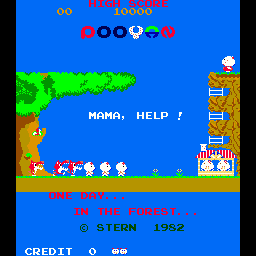 The Game: As a mama pig whose piglets have been abducted by a bunch of mean ol’ wolves, you’re trying to splatter as many wolves as you can. They descend from a tree with balloons, and if you fail to shoot them down at this point, they climb up the tree you’re hanging from and try to bite your butt. (Konami, 1982)
The Game: As a mama pig whose piglets have been abducted by a bunch of mean ol’ wolves, you’re trying to splatter as many wolves as you can. They descend from a tree with balloons, and if you fail to shoot them down at this point, they climb up the tree you’re hanging from and try to bite your butt. (Konami, 1982)
Memories: Pooyan is a wonderfully fun and funny little game, with its almost obscenely cute little piggies and wolves. Like many other cutesy games of the same era, namely Pengo and Blueprint, Pooyan almost seems to have been designed to take advantage of the character marketing mine that Pac-Man and Donkey Kong unearthed. But at its most basic, Pooyan is a sliding shooter game turned at a 90-degree angle.
Pioneer Balloon
 The Game: This is a game about the rough-and-tumble history of the taming of the North American continent, as told by someone who’s never been allowed access to any kind of reading material at all. You pilot a balloon across a scrolling landscape, avoiding (or blasting) birds and bombing a convoy of covered wagons. After conquering this level, you move on to a village of boomerang-throwing natives (and hey, early America was just thick with those puppies, wasn’t it?), followed by coconut-hurling gorillas (another prominent feature on the landscape of the early United States). A brief stage follows in which you must evade a series of random tornadoes, and then you have more wagons to bomb. At least they got something right – there are tornadoes in the U.S. (Rock-Ola [under license from SNK], 1982)
The Game: This is a game about the rough-and-tumble history of the taming of the North American continent, as told by someone who’s never been allowed access to any kind of reading material at all. You pilot a balloon across a scrolling landscape, avoiding (or blasting) birds and bombing a convoy of covered wagons. After conquering this level, you move on to a village of boomerang-throwing natives (and hey, early America was just thick with those puppies, wasn’t it?), followed by coconut-hurling gorillas (another prominent feature on the landscape of the early United States). A brief stage follows in which you must evade a series of random tornadoes, and then you have more wagons to bomb. At least they got something right – there are tornadoes in the U.S. (Rock-Ola [under license from SNK], 1982)
Memories: Before I launch into my tirade on this game, let me just remind you that the team of Rock-Ola and SNK was responsible for my all-time favorite coin-op, Fantasy.
Pirate Pete
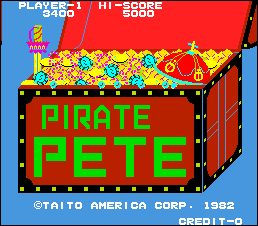 The Game: You are the king of the jung…uh, pirate ship! Swinging from rope to rope! Swimming through shark-infested waters! Jumping and ducking huge rolling boulders! And vanquishing knive-weilding pirates (wait, aren’t they supposed to be on your side if you’re a pirate too?) to rescue the damsel! (Taito, 1982)
The Game: You are the king of the jung…uh, pirate ship! Swinging from rope to rope! Swimming through shark-infested waters! Jumping and ducking huge rolling boulders! And vanquishing knive-weilding pirates (wait, aren’t they supposed to be on your side if you’re a pirate too?) to rescue the damsel! (Taito, 1982)
Memories: So…Pirate Pete. I’m sure you’re not fooled – this is Jungle King again, with different scenery. (At the end of the second stage, the Jungle King / Jungle Hunt music still plays.) A few changes were made to the program itself as well, but not many.
Pepper II
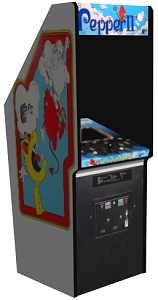 The Game: You’re a little angel (of sorts). You run around a maze consisting of zippers which close or open, depending upon whether or not you’ve already gone over that section of the maze. Zipping up one square of the maze scores points for you, but it gets trickier. Little devils chase you around the maze, trying to kill you before you can zip up the entire screen. If you zip up enough of the maze and grab a power-pellet-like object, you can dispatch some of your pursuers. Clear the screen and the fun begins anew. (Exidy, 1982)
The Game: You’re a little angel (of sorts). You run around a maze consisting of zippers which close or open, depending upon whether or not you’ve already gone over that section of the maze. Zipping up one square of the maze scores points for you, but it gets trickier. Little devils chase you around the maze, trying to kill you before you can zip up the entire screen. If you zip up enough of the maze and grab a power-pellet-like object, you can dispatch some of your pursuers. Clear the screen and the fun begins anew. (Exidy, 1982)
Memories: Once again, the gang at Exidy tries a new twist on the maze game. Sometimes they rock (as with the adventure game Venture – starring Winky! TM, pat. pend.), and sometimes they reek (Mouse Trap, anyone?). This one…this one’s just weird. It’s Amidar weird, and truthfully, the two games are exceedingly similar. There’s not much rationale for the whole thing – angels and devils trying to zip or unzip a maze made out of zippers? Ooooooookay!
Pengo
 The Game: As a cute, fuzzy, harmless little penguin, you roam around an enclosed maze of ice blocks. If this sounds too good to be true – especially for a polar-dwelling avian life form – that’s because you’re not the only critter waddling around in the frozen tundra. Killer Sno-Bees chase little Pengo around the ice, and if they catch up to him and sting him, it’ll cost you a life. But your little flightless waterfowl isn’t completely defenseless. Pengo can push blocks of ice out of the maze, changing the configuration of the playing field and squashing Sno-Bees with a well-timed shove. Clearing the field of Sno-Bees allows you to advance to the next level. (Sega, 1982)
The Game: As a cute, fuzzy, harmless little penguin, you roam around an enclosed maze of ice blocks. If this sounds too good to be true – especially for a polar-dwelling avian life form – that’s because you’re not the only critter waddling around in the frozen tundra. Killer Sno-Bees chase little Pengo around the ice, and if they catch up to him and sting him, it’ll cost you a life. But your little flightless waterfowl isn’t completely defenseless. Pengo can push blocks of ice out of the maze, changing the configuration of the playing field and squashing Sno-Bees with a well-timed shove. Clearing the field of Sno-Bees allows you to advance to the next level. (Sega, 1982)
Memories: This is almost a painfully cute game. Cute, fuzzy characters (both good and bad) waddle around the screen, and even if Pengo gets caught by the Sno-Bees, his little dance of defeat is cute. If you win a few levels, a multicolored lineup of penguins do a little Rockettes-style dance for you. But despite the tooth-rotting overabundance of sweetness, Pengo was a very addictive little game.
Pac-Man Plus
 The Game: As a round yellow creature consisting of a mouth and nothing else, you maneuver around a relatively simple maze, gobbling small dots (10 points) and evading four colorful monsters who can eat you on contact. In four corners of the screen, large flashing dots (50 points) enable you to turn the tables and eat the monsters for a brief period for an escalating score (200, 400, 800 and 1600 points). Periodically, assorted items appear near the center of the maze, and you can consume these for additional points as well. The monsters, once eaten, return to their home base in ghost form and return to chase you anew. If cleared of dots, the maze refills and the game starts again, but just a little bit faster… (Bally/Midway, 1982)
The Game: As a round yellow creature consisting of a mouth and nothing else, you maneuver around a relatively simple maze, gobbling small dots (10 points) and evading four colorful monsters who can eat you on contact. In four corners of the screen, large flashing dots (50 points) enable you to turn the tables and eat the monsters for a brief period for an escalating score (200, 400, 800 and 1600 points). Periodically, assorted items appear near the center of the maze, and you can consume these for additional points as well. The monsters, once eaten, return to their home base in ghost form and return to chase you anew. If cleared of dots, the maze refills and the game starts again, but just a little bit faster… (Bally/Midway, 1982)
Memories: Admittedly this wasn’t an especially unique game, but it does have an interesting history.
Ms. Pac-Man
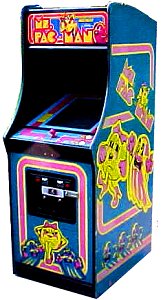 The Game: As the bride of that most famous of single-celled omniphage life forms, your job is pretty simple – eat all the dots, gulp the large blinking dots in each corner of the screen and eat the monsters while they’re blue, and avoid the monsters the rest of the time. Occasionally various fruits and other foods will bounce through the maze, and you can gobble those for extra points. Every so often, just to give you
The Game: As the bride of that most famous of single-celled omniphage life forms, your job is pretty simple – eat all the dots, gulp the large blinking dots in each corner of the screen and eat the monsters while they’re blue, and avoid the monsters the rest of the time. Occasionally various fruits and other foods will bounce through the maze, and you can gobble those for extra points. Every so often, just to give you  a chance to relax, you’ll see a brief intermission chronicling the courtship of Mr. and Mrs. Pac-Man (and a little hint at who the next game would star). (Bally/Midway [under license from Namco], 1982)
a chance to relax, you’ll see a brief intermission chronicling the courtship of Mr. and Mrs. Pac-Man (and a little hint at who the next game would star). (Bally/Midway [under license from Namco], 1982)
Memories: The first real sequel (excluding any altered pirate clones or enhancement kits for the original Pac-Man) in the Pac-Universe, Ms. Pac-Man added quite a few new twists to the original game without changing how it’s played. The new mazes, extra side tunnels (on some mazes), and bouncing fruit were about the only things that could be changed without drastically altering the game (though the later Jr. Pac-Man addition of a scrolling maze was interesting).
Mr. Do!
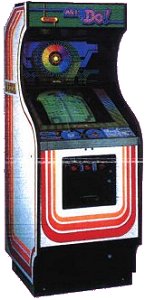 The Game: As the clownlike elfin dweller of a magic garden, you must avoid or do away with a bunch of nasty critters who are after you, while gobbling up as much yummy fruit as you can. (Taito [under license from Universal], 1982)
The Game: As the clownlike elfin dweller of a magic garden, you must avoid or do away with a bunch of nasty critters who are after you, while gobbling up as much yummy fruit as you can. (Taito [under license from Universal], 1982)
Memories: Mr. Do! is a curious chicken-or-the-egg case. Many elements of Mr. Do! are very similar to Dig Dug. However, Mr. Do! is a much more challenging game.
It was also one of the earliest entries from Universal, a company – unrelated to the Hollywood studio of the same name – whose business model appealed to arcade owners, but became a bugbear for competing arcade game manufacturers. Though Mr. Do! was sold as a standalone cabinet licensed through Taito, Universal’s primary product line was “kit games” – a kit with a new circuit board, marquee and cabinet artwork that could transform any cabinet with similar controls into Universal’s latest offering.
Moon Patrol
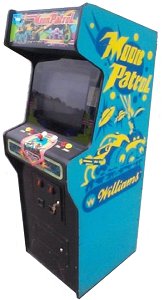
 The Game: Driving an agile, armed moon buggy across the lunar surface, you must jump over craters and land mines, shoot large boulders (some occasionally mobile) out of your way, and try not to be on the receiving end of hostile fire from alien ships that try to strafe you. Some of the ships, which look very suspiciously like the triangle-of-spheres enemy ships from Gyruss, can even bomb the moon and make new craters for you to jump over – which may put you right into their line of fire. Later on, you also get to blast away tanks and dodge pesky jet cars which “tailgate” and then try to ram you. (Williams Electronics [under license from IREM], 1982)
The Game: Driving an agile, armed moon buggy across the lunar surface, you must jump over craters and land mines, shoot large boulders (some occasionally mobile) out of your way, and try not to be on the receiving end of hostile fire from alien ships that try to strafe you. Some of the ships, which look very suspiciously like the triangle-of-spheres enemy ships from Gyruss, can even bomb the moon and make new craters for you to jump over – which may put you right into their line of fire. Later on, you also get to blast away tanks and dodge pesky jet cars which “tailgate” and then try to ram you. (Williams Electronics [under license from IREM], 1982)
Memories: Moon Patrol is a cool game with an actual goal, and with that in mind, it shares a common trait with SNK’s Fantasy – a “continue game” feature which allows you to continue from your last position for just 25 cents more.
Millipede
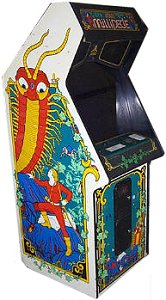
 The Game: Once more unto the breach, your garden of mushrooms is now under attack by a millipede, and the big bug’s even nastier insect entourage has come along too. The spiders, scorpions and fleas are now joined by mosquitoes and inchworms, among others. The only advantage you have? Occasional containers of DDT (can you tell this was the 80’s?) will allow you to wipe out all targets within a given radius…but use them wisely! (Atari, 1982)
The Game: Once more unto the breach, your garden of mushrooms is now under attack by a millipede, and the big bug’s even nastier insect entourage has come along too. The spiders, scorpions and fleas are now joined by mosquitoes and inchworms, among others. The only advantage you have? Occasional containers of DDT (can you tell this was the 80’s?) will allow you to wipe out all targets within a given radius…but use them wisely! (Atari, 1982)
Memories: Another rare Atari sequel – from a company that tended to at least try to stay away from repetition – Millipede of course picks up where Centipede left off – in the same garden, with lots of bugs. A major ad campaign kicked this one off, with Atari using the then-world-champion of Centipede as a spokesperson to verify that this game was, indeed, fun and challenging.
Loco Motion
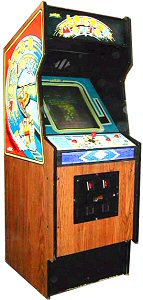 The Game: A train scoots around a twisty maze of tiles representing overpasses, turns, straightaways and terminals. One portion of the maze is blank, and a train will be lost if it hits that blank tile. Using the joystick, you move the blank tile and one adjacent tile around on the map – even if the train is in transit on that tile – in an effort to keep it moving around the maze, picking up passengers. (Passengers that the train can reach are smiley faces; passengers cut off from the main route are frowning.) If any passengers are cut off for an extended period of time, a monster begins wandering that route, and it’ll cost you a train if it comes in contact with your train. You may have to outrun it with the “speed” button in order to pick up the last passengers and clear the level to move on to a bigger maze. (Centuri (under license from Konami), 1982)
The Game: A train scoots around a twisty maze of tiles representing overpasses, turns, straightaways and terminals. One portion of the maze is blank, and a train will be lost if it hits that blank tile. Using the joystick, you move the blank tile and one adjacent tile around on the map – even if the train is in transit on that tile – in an effort to keep it moving around the maze, picking up passengers. (Passengers that the train can reach are smiley faces; passengers cut off from the main route are frowning.) If any passengers are cut off for an extended period of time, a monster begins wandering that route, and it’ll cost you a train if it comes in contact with your train. You may have to outrun it with the “speed” button in order to pick up the last passengers and clear the level to move on to a bigger maze. (Centuri (under license from Konami), 1982)
Memories: A very minor star in the constellation of early Konami coin-ops (Konami also being responsible for Frogger, Time Pilot and Gyruss), Loco Motion is actually a variation on a very old theme: the 2-D sliding tile puzzle.
Liberator

 The Game: So, you’ve always wanted to pilot the Liberator? If you’re talking about the Atari Force’s trusty little flotilla of space fighters, you’re in luck. Your four fighters take up positions at the four corners of the screen, and you use a trackball to aim a cursor; hitting the fire button fires the weapons of the ship nearest the cursor. Basically, the “Malagon Army,” according to the introductory screen, has pulled off a strategic (to say nothing of logistical) coup in invading the entire galaxy – and you and your four fighters are supposed to free…well…the entire galaxy. Hopefully you packed a lunch. At the beginning of your mission, you’re trying to pick off Malagon scout ships in deep space. You then move on to a succession of planets where you have to take out missiles (and the ground bases that hurl them at you) and enemy satellites. Letting a missile through can begin to cost you ships quickly, and when all four fighters are fragged, you’re finished. (Atari, 1982)
The Game: So, you’ve always wanted to pilot the Liberator? If you’re talking about the Atari Force’s trusty little flotilla of space fighters, you’re in luck. Your four fighters take up positions at the four corners of the screen, and you use a trackball to aim a cursor; hitting the fire button fires the weapons of the ship nearest the cursor. Basically, the “Malagon Army,” according to the introductory screen, has pulled off a strategic (to say nothing of logistical) coup in invading the entire galaxy – and you and your four fighters are supposed to free…well…the entire galaxy. Hopefully you packed a lunch. At the beginning of your mission, you’re trying to pick off Malagon scout ships in deep space. You then move on to a succession of planets where you have to take out missiles (and the ground bases that hurl them at you) and enemy satellites. Letting a missile through can begin to cost you ships quickly, and when all four fighters are fragged, you’re finished. (Atari, 1982)
Memories: An interesting game, Liberator, even if it breaks my heart by teasing me with that name and then having nothing to do with the starship of the same name from the 70s BBC space opera Blake’s 7. (Actually, it would almost make as much sense to adapt this game to that storyline as it did to try to attach it to the Atari Force comic books, which were shipped with numerous Atari VCS cartridges but had no prior presence in the arcade.)
Kangaroo
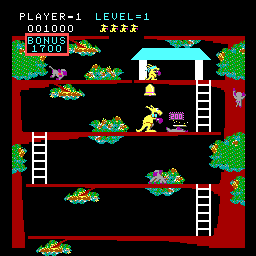 The Game: As a mama marsupial trying to save your baby from many malignant marauding monkeys, you go on a rescue mission that involves climbing through many, many levels of the monkeys’ treehouse village, punching primates, dodging airborne apples, grabbing various fruit items along the way (considering the abundance of apples, strawberries, cherries and bananas, one can only assume these are Pac-Man’s table leavings), and avoiding the big, purple boxing-glove-stealing ape. (Atari [under license from Sun], 1982)
The Game: As a mama marsupial trying to save your baby from many malignant marauding monkeys, you go on a rescue mission that involves climbing through many, many levels of the monkeys’ treehouse village, punching primates, dodging airborne apples, grabbing various fruit items along the way (considering the abundance of apples, strawberries, cherries and bananas, one can only assume these are Pac-Man’s table leavings), and avoiding the big, purple boxing-glove-stealing ape. (Atari [under license from Sun], 1982)
Memories: While some American coin-op game companies jumped on the license-from-Japan bandwagon and scored big early on, such as Midway (who imported Space Invaders and Pac-Man from two different Japanese game makers), Atari was a long-time holdout. Atari’s internal coin-op division was its own internal hit machine, and that simplified things when the consumer division needed hot new arcade titles to translate to the company’s home game consoles.
Jungle King / Jungle Hunt
 The Game: You are the king of the jungle! Swinging from vine to vine! Swimming through crocodile-infested waters! Jumping and ducking huge rolling boulders! And vanquishing spear-weilding natives to rescue the damsel! (Taito, 1982)
The Game: You are the king of the jungle! Swinging from vine to vine! Swimming through crocodile-infested waters! Jumping and ducking huge rolling boulders! And vanquishing spear-weilding natives to rescue the damsel! (Taito, 1982)
 Memories: Not that Jungle King was an incredibly simple game – the above description is supposed to be a little bit humorous, if oversimplified – but Jungle King‘s most infamous footnote in video game history is the lawsuit that it drew. The original Jungle King game opened with the sound of a sampled “Tarzan yell” – and the estate of Edgar Rice Burroughs was not amused.
Memories: Not that Jungle King was an incredibly simple game – the above description is supposed to be a little bit humorous, if oversimplified – but Jungle King‘s most infamous footnote in video game history is the lawsuit that it drew. The original Jungle King game opened with the sound of a sampled “Tarzan yell” – and the estate of Edgar Rice Burroughs was not amused.
Joust
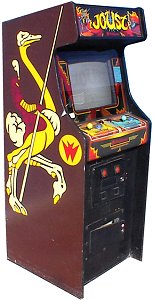 The Game: In the timeless tradition, you suit up in armor, grab a lance, and mount your trusty ostrich. Then you try to impale others who have done the same, and eliminate the remaining “eggs” which will hatch a new warrior if left long enough. Other threats include the almost invincible pterodactyl and the Lava Troll (whose fireyhands assist enemy knights while trying to drag yours into the molten rock). In later levels, there are fewer solid surfaces on which to take refuge. When one of your knights is toppled, another appears, given momentary immunity from harm until he is moved. On second thought, maybe it isn’t all that traditional… (Williams Electronics, 1982)
The Game: In the timeless tradition, you suit up in armor, grab a lance, and mount your trusty ostrich. Then you try to impale others who have done the same, and eliminate the remaining “eggs” which will hatch a new warrior if left long enough. Other threats include the almost invincible pterodactyl and the Lava Troll (whose fireyhands assist enemy knights while trying to drag yours into the molten rock). In later levels, there are fewer solid surfaces on which to take refuge. When one of your knights is toppled, another appears, given momentary immunity from harm until he is moved. On second thought, maybe it isn’t all that traditional… (Williams Electronics, 1982)
Memories: One of the best-remembered games, Joust enjoys a cult following to this day, something which can probably be attributed to the game’s bizarre juxtaposition of perfectly-normal elements (knights in armor trying to kill one another) with the bizarre (lava trolls, flying ostriches as steeds, pterodactyls, knights hatching from eggs). It was a perfect enough mix that Joust has stuck in people’s minds to this day. It was also the only game whose action button served the purpose of flapping the wings of an ostrich.
Jolly Jogger
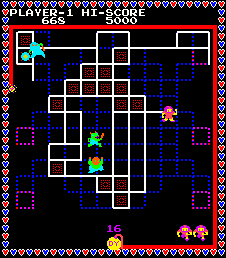 The Game: Players control the Jolly Jogger as he attempts to draw borders around every square area on the playing field. There are several special squares which temporarily give Jolly Jogger the ability to freeze his pursuers for a while; at all other times, they are to be avoided at all costs. Running around every square on the screen clears that level and introduces a new maze of squares where the process begins anew. A lit fuse counts down the time available to Jolly Jogger to complete each screen; if time runs out, a life is lost. (Taito, 1982)
The Game: Players control the Jolly Jogger as he attempts to draw borders around every square area on the playing field. There are several special squares which temporarily give Jolly Jogger the ability to freeze his pursuers for a while; at all other times, they are to be avoided at all costs. Running around every square on the screen clears that level and introduces a new maze of squares where the process begins anew. A lit fuse counts down the time available to Jolly Jogger to complete each screen; if time runs out, a life is lost. (Taito, 1982)
Memories: With a setup and a play mechanic similar to Pepper II and Amidar, Jolly Jogger doesn’t seem to have been a high priority for Taito – even the sell sheet distributed to entice arcade operators and distributors to buy the game seemed lackluster and generic, as if Taito knew it had a game that wasn’t really worthy of prime arcade real estate.
Front Line
 The Game: In a very genteel and almost inappropriately cute game about armored combat, you’re a lone footsoldier fighting your way through a platoon of enemy troops, trying to take out as many of them as you can until you find your way to a handy empty tank. (Nice of the enemy to allow your government to plant friendly tanks behind their borders, isn’t it?) But once you man your own tank, enemy tanks surround you. If one of them hits your tank, you have mere seconds to bail out before your tank blows, and you have to dodge cannon fire until you can find another friendly tank to commandeer. Finally, after crossing hazardous stretches of desert and fighting off entire battallions of enemy tanks, you’re en route to the final confrontation, a showdown with the enemy’s armored headquarters… (Taito, 1982)
The Game: In a very genteel and almost inappropriately cute game about armored combat, you’re a lone footsoldier fighting your way through a platoon of enemy troops, trying to take out as many of them as you can until you find your way to a handy empty tank. (Nice of the enemy to allow your government to plant friendly tanks behind their borders, isn’t it?) But once you man your own tank, enemy tanks surround you. If one of them hits your tank, you have mere seconds to bail out before your tank blows, and you have to dodge cannon fire until you can find another friendly tank to commandeer. Finally, after crossing hazardous stretches of desert and fighting off entire battallions of enemy tanks, you’re en route to the final confrontation, a showdown with the enemy’s armored headquarters… (Taito, 1982)
Memories: Front Line was a really fun and addictive game to play, and was always one of my favorites. I didn’t ever give a thought, at the time, that this game really keeps the player’s vision of warfare from delving into the bloody or the unpleasant, and all the characters – even those octagonal, roly-poly little tanks – are really cute.
Frenzy
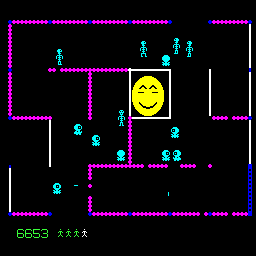 The Game: You’re back in the maze, but this time, the stakes are increased, the danger is increased, and your strategic options are only slightly increased. Touching the walls, the robots, the robots’ laser blasts, or even your own ricocheted lasers are deadly. And of course, the inevitable appearance by Evil Otto is also deadly. However, you can temporarily repel the smiley little bugger by blasting him until his grin turns into the frown – but he will reappear mere seconds later, moving much faster every time he must retreat and reappear – so you’re not doing yourself any favors. If you enter a generator room, you can halt all the robots in their tracks by penetrating the walls surrounding the generator and blasting it. “Beaded” walls can be eaten away, bit by bit, by laser fire from anyone who shoots it, while solid walls will ricochet lasers around until they hit something – which could mean a death trap for you. (Stern, 1982)
The Game: You’re back in the maze, but this time, the stakes are increased, the danger is increased, and your strategic options are only slightly increased. Touching the walls, the robots, the robots’ laser blasts, or even your own ricocheted lasers are deadly. And of course, the inevitable appearance by Evil Otto is also deadly. However, you can temporarily repel the smiley little bugger by blasting him until his grin turns into the frown – but he will reappear mere seconds later, moving much faster every time he must retreat and reappear – so you’re not doing yourself any favors. If you enter a generator room, you can halt all the robots in their tracks by penetrating the walls surrounding the generator and blasting it. “Beaded” walls can be eaten away, bit by bit, by laser fire from anyone who shoots it, while solid walls will ricochet lasers around until they hit something – which could mean a death trap for you. (Stern, 1982)
Memories: I can’t even begin to estimate how many orders of magnitude harder Frenzy is than its inspiration, Stern’s mega-hit Berzerk. There are many times when you have approximately a second – before the characters on the screen begin moving – to assess your strategic situation, which usually isn’t too promising, often placing you in a triangulation of crossfire from three or four different robots that you haven’t even begun to figure out how to reach.
The Electric Yo-Yo
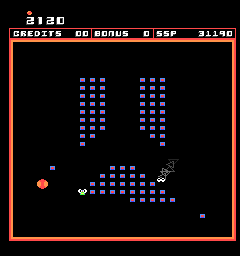 The Game: Don’t take this personally, but you’re a yo-yo in The Electric Yo-Yo, trying to clear all the dots from the screen and trying just as hard to avoid the bug-eyed monsters and other enemies who seem to be natural predators of toys on strings. You must plan your movement around the screen carefully – the further you can move in a straight line to eliminate the most dots, the faster you’ll move.
The Game: Don’t take this personally, but you’re a yo-yo in The Electric Yo-Yo, trying to clear all the dots from the screen and trying just as hard to avoid the bug-eyed monsters and other enemies who seem to be natural predators of toys on strings. You must plan your movement around the screen carefully – the further you can move in a straight line to eliminate the most dots, the faster you’ll move.  Getting stuck in limbo with no targets in the same horizontal or vertical space means you have to take painfully slow baby steps around the screen, making you a sitting duck (or a sitting yo-yo) for your adversaries. You can occasionally grab a flashing dot to give you the power to knock the bug-eyed monster out of the way momentarily. If you clear the screen of dots, a new pattern of dots appears, each one more difficult to complete than the last. (Taito, 1982)
Getting stuck in limbo with no targets in the same horizontal or vertical space means you have to take painfully slow baby steps around the screen, making you a sitting duck (or a sitting yo-yo) for your adversaries. You can occasionally grab a flashing dot to give you the power to knock the bug-eyed monster out of the way momentarily. If you clear the screen of dots, a new pattern of dots appears, each one more difficult to complete than the last. (Taito, 1982)
Memories: Even two years after Pac-Man hit it big, just about everyone was trying to carve out a slice of the dot-gobbling pie with games that, if they weren’t outright ripoffs, were at least conceptually similar. Taito, normally associated with such trail-blazingly original games as Qix and Jungle Hunt, was no exception, but at least The Electric Yo-Yo is far more original than the vast majority of Pac-Man-inspired arcade games.
Eagle
 The Game: As commander of the three-stage fighter rocket Eagle, your job is to ward off endless varieties of evasively weaving space attackers. Every time you knock out two consecutive screens of assailants, you’ll have an opportunity to dock your ship to another one of Eagle’s three stages, until all three portions of the ship are combined to create one bad-ass weapons platform. But you can also lose stages very quickly, ending your game – a bigger ship makes a bigger and easier target. (Centuri [under license from Nichibutsu], 1982)
The Game: As commander of the three-stage fighter rocket Eagle, your job is to ward off endless varieties of evasively weaving space attackers. Every time you knock out two consecutive screens of assailants, you’ll have an opportunity to dock your ship to another one of Eagle’s three stages, until all three portions of the ship are combined to create one bad-ass weapons platform. But you can also lose stages very quickly, ending your game – a bigger ship makes a bigger and easier target. (Centuri [under license from Nichibutsu], 1982)
Memories: Don’t ask me what happened here. I distinctly remember playing both Eagle and Moon Cresta in the arcades and thinking how similar they were. Much later, with the benefit of emulation, I could play both back-to-back and realized what I’d always suspected: they’re the same game!
Eyes
 The Game: The eyes have it, and you apparently want it. You’re also an eye – that’s right, a perfectly normal disembodied eye, wearing a little Oktoberfest hat, wandering through a maze, and shooting at stuff. You’re basically trying to shoot everything on sight. You see, the maze is filled with tiny objects, and you must shoot them all (running over them won’t cut it). The maze is also filled with a number of equally disembodied-and-yet-armed eyes who are out to get you. Clearing the maze of objects advances you to the next level, but you may only get a brief look at it since the eyes are even faster and more aggressive. Rock-Ola [under license from Digitrex Techstar], 1982
The Game: The eyes have it, and you apparently want it. You’re also an eye – that’s right, a perfectly normal disembodied eye, wearing a little Oktoberfest hat, wandering through a maze, and shooting at stuff. You’re basically trying to shoot everything on sight. You see, the maze is filled with tiny objects, and you must shoot them all (running over them won’t cut it). The maze is also filled with a number of equally disembodied-and-yet-armed eyes who are out to get you. Clearing the maze of objects advances you to the next level, but you may only get a brief look at it since the eyes are even faster and more aggressive. Rock-Ola [under license from Digitrex Techstar], 1982
Memories: A bizarre little game among the glut of Pac-Man imitators, Eyes is an obscure little number that falls between the cracks of video game history by being neither particularly outstanding or awful…just strange. In a world where a game about a mobile yellow mouth is king, I don’t think anyone was looking for anything that they could take literally, but Eyes was simply odd.
Donkey Kong Junior
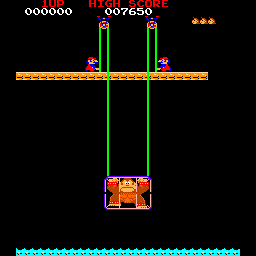 The Game: Mario, in his second-ever videogame appearance, has Donkey Kong in captivity, and it’s up to Donkey Kong Jr. to rescue his dad by scaling vines and chains, avoiding nasty-toothed traps and pesky birds, and reaching the key to free the great ape from Mario’s clutches. (Nintendo, 1982)
The Game: Mario, in his second-ever videogame appearance, has Donkey Kong in captivity, and it’s up to Donkey Kong Jr. to rescue his dad by scaling vines and chains, avoiding nasty-toothed traps and pesky birds, and reaching the key to free the great ape from Mario’s clutches. (Nintendo, 1982)
Memories: Donkey Kong Junior was a really cool game, because it added new ideas to the same general concept as Donkey Kong, resulting in a game that those proficient at the original game wouldn’t find difficult to learn. It was also unique in that the character that you played in Donkey Kong – the hero – was suddenly the villain in this game, and you were out to defeat him.
Domino Man
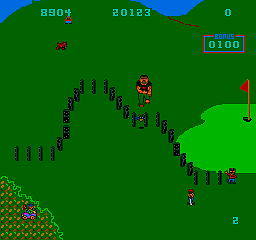 The Game: The town square or the local golf course seems like a reasonable place to set up a huge row of dominoes, doesn’t it? Well, your on-screen protagonist sure seems to think so, and your job is to help him set up his dominoes without allowing any of a number of on-screen “enemies” – such as absent-minded shoppers pushing carts, bees, or a bemuscled bonehead – to knock the dominoes over. (Bally/Midway, 1982)
The Game: The town square or the local golf course seems like a reasonable place to set up a huge row of dominoes, doesn’t it? Well, your on-screen protagonist sure seems to think so, and your job is to help him set up his dominoes without allowing any of a number of on-screen “enemies” – such as absent-minded shoppers pushing carts, bees, or a bemuscled bonehead – to knock the dominoes over. (Bally/Midway, 1982)
Memories: Another incredibly fun and offbeat coin-op from the gang at Bally/Midway, Domino Man was a whimsical little number which set all of its action to the music of ragtime maestro Scott Joplin. If only for that reason, this was one of the few arcade games that my mother used to get a kick out of (not that she tried it herself, of course – she just kept chuckin’ quarters at me, bless her heart).
Dig Dug
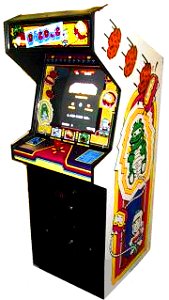 The Game: You are Dig Dug, an intrepid gardener whose soil is infested with pesky Pookas and fire-breathing Fygars. You’re armed with your trusty pump, which you can use to inflate your enemies until, finally, they blow up. But both the Pookas and Fygars can crawl through the ground and can pop out into your tunnels, and if
The Game: You are Dig Dug, an intrepid gardener whose soil is infested with pesky Pookas and fire-breathing Fygars. You’re armed with your trusty pump, which you can use to inflate your enemies until, finally, they blow up. But both the Pookas and Fygars can crawl through the ground and can pop out into your tunnels, and if  a Fygar sneaks up behind you, he can toast you if you’re not careful. Who said landscaping was easy? (Atari [under license from Namco], 1982)
a Fygar sneaks up behind you, he can toast you if you’re not careful. Who said landscaping was easy? (Atari [under license from Namco], 1982)
Memories: Dig Dug, with its animè-inspired cutesy characters and exceedingly simple game play, was a wonderfully easy game to learn, and it didn’t take much effort to reach a high score. (Dig Dug II, on the other hand, relied on a strange pseudo-3D, slightly-but-not-quite-overhead perspective which added to the difficulty, creating problems similar to playing Zaxxon or Congo Bongo.) With its simplicity and cuteness, Dig Dug was big with the younger set.
Disco No. 1
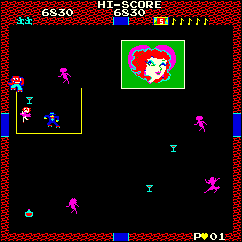 You’re on the dance floor, they’ve dimmed the lights, the feeling is right, and you’re gonna boogie tonight. Leaving temporary, light-cycle-style tracers behind you, you have to impress all the lovely ladies by literally skating circles around them. When you accomplish this, you claim a bit of territory on the dance floor. (Data East, 1982)
You’re on the dance floor, they’ve dimmed the lights, the feeling is right, and you’re gonna boogie tonight. Leaving temporary, light-cycle-style tracers behind you, you have to impress all the lovely ladies by literally skating circles around them. When you accomplish this, you claim a bit of territory on the dance floor. (Data East, 1982)
And here you thought Xanadu was the only pop culture celebration of roller disco – not so! This bizarre little coin-op number brings roller boogie back from the brink of extinction (being the voracious second-hand consumers of American pop culture that they were, God bless ’em, the Japanese apparently missed the memo that disco was “dead” by this point).
Changes
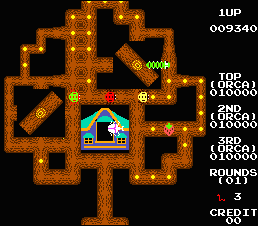 The Game: Players guide a caterpillar around a maze of twigs and branches, snatching up nourishment and the occasional treat, and avoiding other insect life; some parts of the branches can be turned. Some of the treats will allow the caterpillar to consume other insects for a brief time. Portions of the maze can be rotated, which can work against the player (cutting off the best or only escape route) or can work to the player’s advantage (effectively shutting a door in pursuers’ faces, or even smashing them if they’re in the wrong place at the right time). Clearing the maze allows the caterpillar to turn into a butterfly and escape (who needs a pupal stage anyway?); the player advances to the next level, where a new caterpillar needs help navigating a new maze. (Orca, 1982)
The Game: Players guide a caterpillar around a maze of twigs and branches, snatching up nourishment and the occasional treat, and avoiding other insect life; some parts of the branches can be turned. Some of the treats will allow the caterpillar to consume other insects for a brief time. Portions of the maze can be rotated, which can work against the player (cutting off the best or only escape route) or can work to the player’s advantage (effectively shutting a door in pursuers’ faces, or even smashing them if they’re in the wrong place at the right time). Clearing the maze allows the caterpillar to turn into a butterfly and escape (who needs a pupal stage anyway?); the player advances to the next level, where a new caterpillar needs help navigating a new maze. (Orca, 1982)
Memories: Just like Hollywood blockbusters, there’s development turnaround time for video games, both then and now. That may explain why this Pac-Man knockoff didn’t show up in arcades until long after the Pac-saga itself had moved on to such titles as Ms. Pac-Man and Super Pac-Man.
Buck Rogers: Planet Of Zoom
 The Game: Zoom being the operative word here, your mission – as space hero Buck Rogers – is to fly in close quarters with all kinds of enemy ships, landers and structures, fending off their attacks, and generally staying alive as long as possible. Obligatory robot wisecracks and utterances of “beedy-beedy-beedy” not included. (Sega, 1982)
The Game: Zoom being the operative word here, your mission – as space hero Buck Rogers – is to fly in close quarters with all kinds of enemy ships, landers and structures, fending off their attacks, and generally staying alive as long as possible. Obligatory robot wisecracks and utterances of “beedy-beedy-beedy” not included. (Sega, 1982)
Memories: Debuting in arcades a mere two years after the exit of the popular but troubled Buck Rogers TV series, Sega’s coin-op had no real connection with it. If anything, the enemy ships and architecture in Planet Of Zoom are a bit more art deco, suggesting the comic book roots of Buck Rogers. Sega later ported the game to a few home consoles, and while the player’s ship in those games seemed to hearken back to the sleek fighters of the TV series, it was more likely a case of simplifying the arcade game’s fancy rocketship.
BurgerTime

 The Game: As Chef Peter Pepper, you climb around a multi-level factory whose sole function is to make some really big burgers. We’re talking about some BIG burgers here. But your ingredients aren’t exactly cooperating with you. Mr. Hot Dog, Mr. Egg and Mr. Pickle are doing their best to keep you from making those big burgers, but you can turn the tables on them and put them in your edible creations! You have a limited supply of pepper which you can use to stun your tasty stalkers (and keep in mind, this was years before Mace). Or you can simply lead them across one of the yummy ingredients, and they’ll become part of the burger. (Which is a rather disturbing thought when it comes to to hot dogs and eggs in a hamburger.) Also, you can walk across a bun or a slab of meat on the level above them, and the falling ingredients will squash them on the way down. (Bally/Midway [under license from Data East], 1982)
The Game: As Chef Peter Pepper, you climb around a multi-level factory whose sole function is to make some really big burgers. We’re talking about some BIG burgers here. But your ingredients aren’t exactly cooperating with you. Mr. Hot Dog, Mr. Egg and Mr. Pickle are doing their best to keep you from making those big burgers, but you can turn the tables on them and put them in your edible creations! You have a limited supply of pepper which you can use to stun your tasty stalkers (and keep in mind, this was years before Mace). Or you can simply lead them across one of the yummy ingredients, and they’ll become part of the burger. (Which is a rather disturbing thought when it comes to to hot dogs and eggs in a hamburger.) Also, you can walk across a bun or a slab of meat on the level above them, and the falling ingredients will squash them on the way down. (Bally/Midway [under license from Data East], 1982)
Memories: BurgerTime was a cool twist on the climbing genre, but it had one main problem – oh, boy, was it ever slow! I t took forever to climb ladders, and on those later levels where there were huge, dangerous stretches of ladders, this slowed the game down to an annoyingly slow pace. Other than this, though, it was a nifty little game, and just playing it and writing about it has made me hungry for something from Burger King…
Black Widow
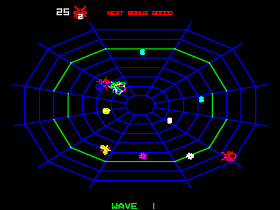
 The Game: You’re a spider whose web seems to be a popular hangout for any number of flies who seem to have an aversion to getting caught there. So you’re left with the only option nature leaves open to a spider in this scenario: you shoot your prey down and eat the yummy grubsteak that’s left behind! Some bugs will have the whaudacity to lay their eggs in your web, which you can either push off the edge (a risky trick depending on how “developed” some of the eggs are) or wait to hatch into more bugs that you can shoot down. Beware of “grenade bugs” which destroy everything within a certain radius around them when you shoot them; they may take out other adversaries as they go, or destroy you if you’re too close. (Atari, 1982)
The Game: You’re a spider whose web seems to be a popular hangout for any number of flies who seem to have an aversion to getting caught there. So you’re left with the only option nature leaves open to a spider in this scenario: you shoot your prey down and eat the yummy grubsteak that’s left behind! Some bugs will have the whaudacity to lay their eggs in your web, which you can either push off the edge (a risky trick depending on how “developed” some of the eggs are) or wait to hatch into more bugs that you can shoot down. Beware of “grenade bugs” which destroy everything within a certain radius around them when you shoot them; they may take out other adversaries as they go, or destroy you if you’re too close. (Atari, 1982)
Memories: Black Widow is a fun number which smacks of an attempt to do Robotron: 2084 in vector graphics. It’s also one of the handful of Atari arcade games sporting the color vector monitor, which was prone to numerous technical glitches (not the least of which was overheating to the point that capacitors melted off the board). What vector graphics had over traditional raster displays, however, was fast action, and Black Widow is a beauty in that respect. Within only a few levels, the action is almost too much for the average player to handle.